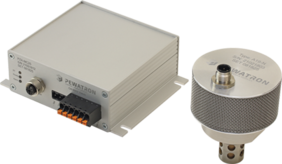Angst+Pfister presents its new PZA-MC25-N and PZA-MC25-P potentiometric oxygen sensor modules

The potentiometric measuring principle for oxygen sensing has the widest range of concentration ranges among all oxygen sensing technologies – from 10-35 bar O2 and up to 100% O2. The physics may be complex, but the concept is easy to understand – one side of a heated zirconia element is exposed to the sample gas with an unknown oxygen gas concentration and the other side to a known reference oxygen gas concentration. The difference in oxygen partial pressure between the two sides generates an equilibrium constant voltage (charge balance). For accurate and reliable measurements of the unknown oxygen gas concentration, the temperature of the heated zirconia element needs to be controlled very accurately and the reference oxygen gas concentration, CO2 (Pabs,ref, Tref, Href), must be known.
Angst+Pfister Sensors and Power has two types of OEM potentiometric oxygen gas sensors and gas sensor modules in its program – sensors/modules for inline, diffusion measurements and sensors/modules for forced flow measurements. The sensors for the inline, diffusion measurements can be designed for temperatures up to 1400°C. The most popular inline, diffusion sensor is the A19-N oxygen sensor that has an upper temperature limit of 200°C and which can be easily screw-mounted and gas tightened into a process chamber or a process line. For forced flow measurements, the A19-P oxygen sensor is the obvious choice. The gas inlet (G3/8”) and gas outlet (G1/4”) design ensures a very fast response to changes in the oxygen concentration and no pressure build-up over the zirconia element.
For controlling and regulating the temperature, as well as also conditioning the output signal, the MC electronics is recommended. The electronics controls the temperature very accurately and the conditioning electronics amplifies the mV output signal into a 4-20 mA output signal that can be managed easily in for instance a PLC module.
The MC electronics has two measurement ranges. The reason for having two measurements ranges is that most users operate the sensor module during the process in a low oxygen concentration atmosphere (< 10.000 ppm), but that most users also need either to control the oxygen concentration during start-up of the process or would like to check the output signal in air before starting the process. The standard configuration offered by Angst+Pfister Sensor and Power is 0-1000 ppm/0-25% measurement ranges with a possibility of automatic switchover between the measurement ranges by use of a potential-free contact.
The most popular application, among many, for the PZA-MC25-N potentiometric oxygen sensor module for inline, diffusion measurements is in additive manufacturing (AM) applications for controlling the inert gas conditions in powder bed based build chambers. The first measurement range (0-25%) is used for getting a good-for-go for the build job to be started, because the oxygen concentration is lower than a preset value for safe operation. The second range (0-1000 ppm) is used to control and monitor the oxygen concentration level during the build job. Most reactive metals, like titanium or aluminum, must be build in a very low oxygen atmosphere – preferably below 200 ppm O2.
One of the most popular applications for the PZA-MC25-P potentiometric oxygen sensor module for forced flow measurements is in metal powder atomizer/separator machine for securing oxidation free processing in a closed chamber machine. Because of the conditions in the chamber, the gas-to-be-analyzed is extracted and analyzed using the PZA-MC25-P product and with process limits as low as 10 ppm. The PZA-MC25-P not only monitors the conditions before start of the process; during the process it measures the quality of the process, for instance by being able to measure leakage into the closed chamber.
The mV output signal from the potentiometric zirconia oxygen sensors is highly non-linear, in fact it is logarithmic. The MC electronics linearizes the signal and deliver per default a linearized 4-20 mA signal. The linearization somewhat limits the useful oxygen concentration range and it is not recommended to use a measurement range in the linear mode better/lower than 0-1 ppm. For some applications, for instance those where a reducing gas can interfere with the oxygen gas on the surface of the zirconia, it is recommended to switch to the logarithmic measurement mode. In the logarithmic mode the concentration range can be very broad, but the output signal is still 4-20 mA, but logarithmic. Switching to logarithmic makes sense, when a reducing gas reduces the partial pressure of oxygen on the measurement side below the ppb level. For instance in processes using a forming gas or for very precise measurements of oxygen below the ppm level.
All changes, be it an adjustment of the cable length between the sensor head and the electronics over a customer specific setting of the measurement range to a change between linear and logarithmic mode, is easily done using the Windows App and the Bluetooth connection in the electronics. Calibration, diagnostics and change of settings are all done in this way. All PZA-MC25-N/P are delivered with a very precise calibration and a calibration certificate, but it is recommended, and often needed, to make a adjustment/calibration in the applications. Small changes in pressure, flow or humidity can causes rather large deviations from pre-calibrated values. From the electronics unit, there is also the possibility of dumping the data into a csv file format by using the PC Software for logging.
For more information, please visit http://www.pewatron.com.
News Categories
- » NEWS HOME
- » Automation & Robotics
- » Industry 4.0
- » Material Handling
- » Sensors
- » Quality & Testing
- » Machine Vision
- » Laser & Optics
- » Metalworking
- » Motion Control & Drives
- » Hydraulics & Pneumatics
- » Process Industry
- » Renewable Energy
- » Agriculture
- » Home & Office Furniture
- » Environmental Tech

